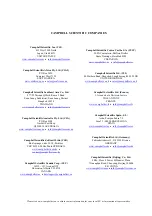
CS300 and CS301 Pyranometers
9
the procedure in Appendix
Importing Short Cut Code Into CRBasic Editor
. Programming basics for CRBasic dataloggers are provided in the
following sections. Complete program examples for select CRBasic
dataloggers can be found in Appendix
.
Programming basics and programming examples for Edlog dataloggers are
provided at
www.campbellsci.com\old-manuals
The output from the pyranometer is 0.2 mV per Wm
–2
. Its voltage signal is
measured by using the
VoltSE()
CRBasic instruction.
Solar radiation can be recorded as an average flux density (W m
–2
) or daily
total flux (MJ m
–2
). The appropriate multipliers are listed in TABLE
Campbell Scientific recommends setting negative values to zero before those
values are processed.
TABLE 7-2. Multipliers Required for Average Flux
and Total Flux Density in SI and English Units
UNITS
MULTIPLIER
PROCESS
W m
-2
5.0
Average
MJ m
-2
t • 0.000005
Total
kJ m
-2
t • 0.005
Total
cal cm
–2
min
–1
0.005 • (1.434)
*
Average
cal cm
–2
t • 0.005 • (0.0239)
Total
t = datalogger execution interval in seconds
*
Joules/Cal ratio = 4.184 J/cal
Possible sources of electrical noise include nearby ac power lines, electric
pumps, or motors. If the sensor or datalogger is located in an electrically noisy
environment, use the 60 or 50 Hz rejection integration option as shown in the
example programs.
7.4.1
Total Solar Radiation
If solar radiation is totalized in units of kJ m
–2
, there is a possibility of over
ranging the output limits. For CRBasic dataloggers, avoid this by using the
IEEE4 or long data format.
8.
Maintenance and Calibration
On a monthly basis, check the level of the pyranometer. Remove dust or debris
from the sensor head by blasting the sensor head with compressed air or by
cleaning with a soft bristle, camel hair brush.
Handle the sensor carefully when cleaning. Be careful not
to scratch the surface of the sensor.
Recalibrate the CS300 or CS301 every three years. Refer to the
Assistance
page at the beginning of this document for the process of returning the
pyranometer to Campbell Scientific for recalibration.
CAUTION








































